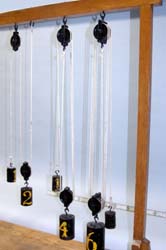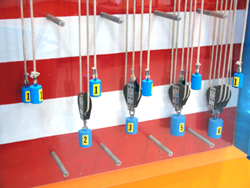|
Size: 2586
Comment:
|
Size: 3069
Comment: converted to 1.6 markup
|
| Deletions are marked like this. | Additions are marked like this. |
| Line 2: | Line 2: |
| ||<:30%>[:PiraScheme#Mechanics: Table of Mechanics Demonstration]||<:30%>[:MEEquipmentList: List of Mechanics Equipment & Supplies]||<:30%>[:Demonstrations:Lecture Demonstrations]|| | ||<:30%>[[PiraScheme#Mechanics| Table of Mechanics Demonstration]]||<:30%>[[MEEquipmentList| List of Mechanics Equipment & Supplies]]||<:30%>[[Demonstrations|Lecture Demonstrations]]|| |
| Line 7: | Line 7: |
| Work and Energy, [:WorkEnergy#SimpleMachines: 1M20. Simple Machines] | Work and Energy, [[WorkEnergy#SimpleMachines| 1M20. Simple Machines]] |
| Line 10: | Line 10: |
| * '''Floor Item''' [:MechanicsCabinet:Mechanic (ME)] | * '''Floor Item''' [[MechanicsCabinet|Mechanic (ME)]] |
| Line 13: | Line 13: |
| attachment:BlockTackle03-400.jpg | {{attachment:BlockTackle03-400.jpg}} |
| Line 28: | Line 28: |
| 1. Point out the weights used in each system and discuss the mechanical advantage of the systems. | |
| Line 33: | Line 34: |
| A block and tackle is a system composed of two or more pulleys with a rope or cable threaded between them, usually used to lift or pull heavy loads. Such systems are commonly used in construction and sailing, working by the principle of mechanical advantage(more on this below). The rotation of the pulleys change the direction of an applied force, and they can even reduce the force needed to lift a heavy weight when configured appropriately. This particular assortment of block and tackle systems consists of four configurations, a 1:1, 1:2, 1:4, and 1:6. Each added pair of pulleys doubles the amount of rope one has to pull to lift that weight to the same height. | |
| Line 34: | Line 36: |
| Pulleys are mechanisms compost of one or more wheels and a rope threaded though them and attached to some heavy object so that it can be lifted without much effort. Showing the principle of mechanical advantage. The rotation of the pulleys change the direction of an applied force and they can even reduce the force needed to lift a heavy weight, like a piano. Pulleys systems are common used in constructions. This systems of one to four pulley systems, a 1 to 1, 1 to 2, 1 to 4, and 1 to 6. Each doubling, doubles the amount of rope one has to pull to lift that weight to the same height, say lift a 1lb weight to a height of 1 ft. | Mechanical advantage is defined as a ratio of input/output forces: N = F,,in,, / F,,out,, = number of pulley in parallel. For an example, if there are six such pulleys then the mechanical advantage is 6. If tension of 1 N is applied, the output force will be 6 N at the cost of having to pull 6 times as much rope. |
| Line 41: | Line 43: |
| ||attachment:BlockTackle05-250.jpg||attachment:BlockTackle04-250.jpg||attachment:Pullies-1i.jpg||attachment:Pullies-2i.jpg|| | ||{{attachment:BlockTackle05-250.jpg}}||{{attachment:BlockTackle04-250.jpg}}||{{attachment:Pullies-1i.jpg}}||{{attachment:Pullies-2i.jpg}}|| |
| Line 44: | Line 46: |
| * [https://www.youtube.com/user/LectureDemostrations/videos?view=1 Lecture Demonstration's Youtube Channel] | * [[https://www.youtube.com/user/LectureDemostrations/videos?view=1|Lecture Demonstration's Youtube Channel]] |
| Line 48: | Line 50: |
| * [http://en.wikipedia.org/wiki/Block_and_tackle Block and Tackle - Wikipedia] * [http://www.physics.wisc.edu/museum/Exhibits-1/Mechanics/Pulleys/index_Pulleys.html L.R. Ingersoll Physics Museum] |
* [[http://en.wikipedia.org/wiki/Block_and_tackle|Block and Tackle - Wikipedia]] * [[http://www.physics.wisc.edu/museum/Exhibits-1/Mechanics/Pulleys/index_Pulleys.html|L.R. Ingersoll Physics Museum]] |
| Line 52: | Line 54: |
| [:Instructional:Home] | [[Instructional|Home]] |
Block and Tackle Pulley Systems and Pulley Advantage, 1M20.11
Topic and Concept:
Work and Energy, 1M20. Simple Machines
Location:
Floor Item Mechanic (ME)
- There is another system within the physics museum

Abstract: An assortment of four different pulley systems is suspended from a frame showing the principle of mechanical advantage.
Equipment |
Location |
ID Number |
|
|
|
apparatus |
ME, Floor Item |
1M20.11 |
Important Setup Notes:
- N/A
Setup and Procedure:
- Position the rack so that the audience has a good view of all of the pulley systems.
- Point out the weights used in each system and discuss the mechanical advantage of the systems.
Cautions, Warnings, or Safety Concerns:
- N/A
Discussion: A block and tackle is a system composed of two or more pulleys with a rope or cable threaded between them, usually used to lift or pull heavy loads. Such systems are commonly used in construction and sailing, working by the principle of mechanical advantage(more on this below). The rotation of the pulleys change the direction of an applied force, and they can even reduce the force needed to lift a heavy weight when configured appropriately. This particular assortment of block and tackle systems consists of four configurations, a 1:1, 1:2, 1:4, and 1:6. Each added pair of pulleys doubles the amount of rope one has to pull to lift that weight to the same height.
Mechanical advantage is defined as a ratio of input/output forces: N = Fin / Fout = number of pulley in parallel. For an example, if there are six such pulleys then the mechanical advantage is 6. If tension of 1 N is applied, the output force will be 6 N at the cost of having to pull 6 times as much rope.
Example:
In order to lift the 1lb weight W you have to apply a force of F on the rope equal to the weight W. The rope is now under a tension T equal to the force F. To lift this weight a distance of H=1 ft you will have to pull in a length L= H=1 ft of the rope. The mechanical advantage M is one: M=W/F=1.
|
|
|
|
Videos:
References:



